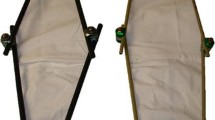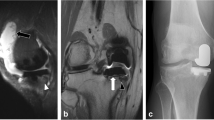Abstract
We analysed the reason for knee pain after intramedullary (IM) nailing with standard MRI sequences at a mean of 27 months (range 2–45) after nail removal in eleven patients with a mean age of 30 years (range 15–52). Knee pain was assessed in four grades. All our patients had signal changes of fluid in the nail channel, areas of low signal intensity in Hoffa’s fat pad and subcutaneous low signal nodes in front of a thickened patellar ligament. Ten patients had low signal adhesions from the nail insertion towards the patellar ligament. Six patients had severe knee pain and even marked adhesions. Two patients had no knee pain; one of these two had minimal adhesions and the other one no adhesions. Five of the patients had a meniscal tear and/or local cartilage reduction. The degree of adhesions from the nail insertion in the tibia towards the patellar ligament was proportional to the degree of knee pain. No sign of acute inflammation was found.
Similar content being viewed by others
References
Alberts KA, Loohagen G, Einarsdottir H (1999) Open tibial fractures: faster union after unreamed nailing than external fixation. Injury 30:521–522
Anglen JO, Mark Blue J (1995) A comparison of reamed and unreamed nailing of tibia. J Trauma 39:352–354
Bono CM, Levine RG, Rao JP, Behrens FF (2001) Nonarticular proximal tibia fractures: treatment options and decision making. J Am Acad Orthop Surg 9:176–186
Keating JF, Phil M, O’Brien PJ et al (1997) Locking intramedullary nailing with and without remaing for open fractures of the tibial shaft: a prospective randomized study. J Bone Joint Surg Am 79:339
Shannon FJ, Mullet H, O’Rourke K (2002) Unreamed intramedullary nailing versus external fixation in grade III open tibial fractures. J Trauma 52:652
Singer RW, Kellam JF (1995) Open tibial diaphyseal fractures: Results of unreamed locked intramedullary nailing. Clin Orthop Relat Res 315:115–117
Whittle AP, Russel TA, Taylor JC, Lavelle DG (1992) Treatment of open fractures of the tibial shaft with the use of interlocking nailing without remaing. J Bone Joint Surg Am 74:1166–1168
Schandelmaier P, Krettek C, Rudolf J et al (1997) Superior results of tibial rodding versus external fixation in grade IIIB fractures. Clin Orthop Relat Res 342:169
Georgiadis GM (1995) Tibial shaft fractures complicated by compartment syndrome. J Trauma 38:449–451
Koval KJ, Clapper MF, Brumback RJ et al (1991) Complications of reamed intramedullary nailing of the tibia. J Orthop Trauma 5:184–189
Karlström G, Olerud S (1974) Fractures of the tibial shaft: a critical evaluation of treatment alternatives. Clin Orthop Relat Res 105:82–115
Court-Brown CM, Gustilo T, Shaw AD (1997) Knee pain after intramedullary tibial nailing: its incidence, etiology, and outcome. J Orthop Trauma 11:103–105
Keating JF, Orfaly R, O’Brien PJ (1997) Knee pain after tibial nailing. J Orthop Trauma 11:10–13
Toivanen JA, Vaisto O, Kannus P et al (2002) Anterior knee pain after Intramedullary nailing of fractures of the tibial shaft. A prospective, randomized study comparing two different nail insertion techniques. J Bone Joint Surgery Am 84:580–585
Gustillo RB, Mendoza RM, Williams DN (1984) Problems in the management of type III (severe) open fractures: a new classification of type III open fractures. J Trauma 24:740–743
Müller ME, Nazarian S, Koch P, Schatzker J (1990) The comprehensive classification of fractures of long bones. Springer-Verlag, Berlin, Heidelberg, New York
Greenspan A (1999) Orthopaedic radiology. Lippincott Williams Wilkins, Philadelphia, pp 52–54
Winquist RA, Hansen ST Jr (1980) Comminuted fractures of the femoral shaft treated by intramedullary nailing. Clin Orthop N Am 11:633–648
Lindgren U, Svensson O (1996) Ortopedi. Almqvist & Wiksell Medicin/Liber, Stockholm, p 145
Cotran RS, Kumar V, Robbins SL (1999) Robbins pathologic basis of disease. Saunders, Oxford, pp 50–86
Teller P, König H, Weber U, Hertel P (2003) MRI atlas of orthopedics and traumatology of the knee. Springer-Verlag, Berlin, New York, p 163
Schild H, Muller HA, Menke W (1982) Computer tomography after medullary nailing of the tibia. ROFO Fortschr Geb Rontgenstr Nuklearmed 137:554–560
Braten M, Nordby A, Terjesen T, Rossvoll I (1992) Bone loss after locked intramedullary nailing. Computed tomography of the femur and tibia in 10 cases. Acta Orthop Scand 63:310–314
Kroger H, Kettunen J, Bowditch M et al (2002) Bone mineral density after the removal of intramedullary nails: a cross-sectional and longitudinal study. J Orthop Sci 7:325–330
Glotzer W (1993) Measuring intraosseous pressure and osseous venography of the patella in anterior knee pain. Part II. Unfallchirurgiie 96:271–281
Mao BY (1993) The change of intraosseous pressure in the femur and tibia near knee and knee pain. Zhonghua Wai Ke Za Zhi 31:593–595
Miltner O, Siebert CH, Schneider U et al (2003) Patellar hypertension syndrome in adolescence: a three-year follow up. Arch Orthop Trauma Surg 123:455–459
Schneider U, Breusch SJ, Thomsen M et al (2000) A new concept in the treatment of anterior knee pain: patellar hypertension syndrome. Orthopedics 23:581–586
Ellis H (1958) Disability after tibial shaft fractures, with special reference to Volkmann’s ischemic contracture. J Bone Joint Surg Br 40:190
Horne G, Iceton J, Twist J, Malony R (1990) Disability following fractures of the tibial shaft. Orthopedics 13:423–426
McMaster MJ, James JI (1976) Disability of the hindfoot after fracture of the tibial shaft. J Bone Joint Surg 58:90–93
Mulhall KJ, Dowdall J, Grannell M, McCabe JP (1999) Tibial spine fractures: an analysis of outcome in surgically treated type III injuries. Injury 30:289–292
Author information
Authors and Affiliations
Rights and permissions
About this article
Cite this article
Gustafsson, J., Toksvig-Larsen, S. & Jonsson, K. MRI of the knee after locked unreamed intramedullary nailing of tibia. Chir Organi Mov 91, 45–50 (2008). https://doi.org/10.1007/s12306-007-0008-1
Received:
Accepted:
Published:
Issue Date:
DOI: https://doi.org/10.1007/s12306-007-0008-1




